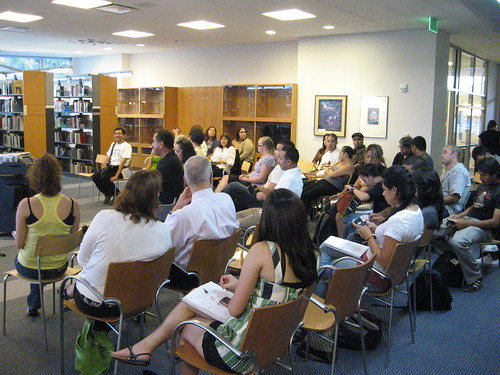The Podcast I chose was from ESL Pod--the episode 885 Talking to a bank teller. Even though I have been in and out of Bank of America for several times, I am not sure I talked to the teller in a very right way. So I took this chance to learn some specific words, phrases and dialogues using in a bank. And what is more important is that I can use the series of ESL Podcast in my future teaching. It will be a very useful resource website for my students to learn and be familiar with real English conversations.
In this Talking to a bank teller podcast, the speaker firstly presents a dialogue between a person who works in the bank and Antonio. It is a normal conversation about how to deposit and draw money and how to get cash check and pay bill. The conversation is based on real life so that students can imitate and remember all the words and phrases. The best part of the podcast is that the speaker gives a very well organized and clear explanation of the whole conversation. He points out key words like deposit,draw and cash and explain those words and phrases by real life examples. Thus, students will understand those new words and phrases by shown situations they may have been through rather than just recite them. And speakers also explain pronunciation and spelling of some complicated words like receipt,balance or transfer that may confuse beginning level English learners. Moreover, I like the way the speaker uses easier English language to explain more difficult English language. It is nice to immerse my students in a environment of English by using L1 to explain L1. In this case, students won't think about Chinese all the time.
I like the aspect that the ESL Podcast based on real like conversation which lacks in Chinese official English textbooks. A lot of conversations I learned in China I have never heard of them in America. So what can a teacher once studying abroad bring to her students? I believe, at least, it is real English.
In this Talking to a bank teller podcast, the speaker firstly presents a dialogue between a person who works in the bank and Antonio. It is a normal conversation about how to deposit and draw money and how to get cash check and pay bill. The conversation is based on real life so that students can imitate and remember all the words and phrases. The best part of the podcast is that the speaker gives a very well organized and clear explanation of the whole conversation. He points out key words like deposit,draw and cash and explain those words and phrases by real life examples. Thus, students will understand those new words and phrases by shown situations they may have been through rather than just recite them. And speakers also explain pronunciation and spelling of some complicated words like receipt,balance or transfer that may confuse beginning level English learners. Moreover, I like the way the speaker uses easier English language to explain more difficult English language. It is nice to immerse my students in a environment of English by using L1 to explain L1. In this case, students won't think about Chinese all the time.
I like the aspect that the ESL Podcast based on real like conversation which lacks in Chinese official English textbooks. A lot of conversations I learned in China I have never heard of them in America. So what can a teacher once studying abroad bring to her students? I believe, at least, it is real English.













